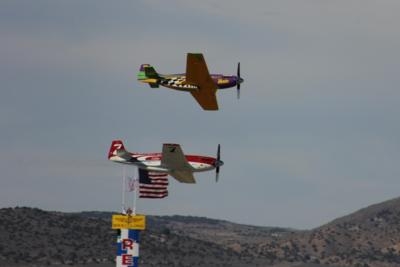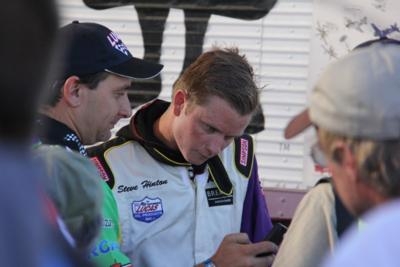Hinton’s Days Of Watching, Working On, And Flying The Fastest Airplanes In The World.
Part 1 of 2 By Maria Morrison
Late on a Friday night, nearly three weeks after the conclusion of the Reno National Championship Air Races, Steven Hinton, Jr., is sitting in a mechanic’s shop with Voodoo, a highly modified P-51 D Mustang. The pair claimed the Unlimited Gold trophy this year, upping Hinton’s record to six consecutive wins at Reno.
Still holding the record for youngest Breitling Gold champion at age 22, “Stevo”, now 27, is continuing to race and work on warbirds in his day-to-day life. Even once the week in Reno drew to a close, with Steve and Voodoo taking first place on Sunday, his work was far from over. After turning in the engraved trophy (which stays in Reno) at Sunday's award banquet for a smaller award to take home, he and a few other members of the Voodoo crew began their work. They changed the Merlin racing engine to a stock one at the aircraft's home base in Yolo County, CA. Steve then returned to Reno to make the same changes to another race plane, Strega.

In Hinton's first four years of racing, he piloted this red-and-white Mustang throughout the roughly 60 mile race, under the constant watch and teaching of Strega's owner and pilot, Bill "Tiger" Destefani. Last year, Steve switched to Voodoo, and, in 2014, Tiger returned to racing for one year in Strega to race against his student Hinton. Their showdown on Saturday was what many people are calling the best racing in years. While Hinton kept his steady race line, Destefani climbed higher throughout the race, diving down on Voodoo in the last seconds and gaining speed on the descent. The finish was nearly too close to call, with merely a spinner-length between the two. Who finished first, however, became irrelevant when it was revealed that Destefani was disqualified for going above the FAA altitude restrictions of the course. He hung up his flying suit the next day, and Strega was grounded with significant engine damage.
Despite the competition, however, Stevo and Tiger remain friends, to the easy extent that Steve returned to Reno to change Strega's racing engine back to stock. Part of this change had to do with the fact that Strega's Merlin race engine was, as Steve plainly put it; broken. Additionally, Breitling was filming a commercial in Mojave, starring Voodoo and Strega. Steve and his father, Hinton Sr., flew the aircraft down to the desert, Voodoo from Yolo County and Strega from Shafter, CA. The work leading up to this commercial and the maintenance afterward have made Steve's post-Reno weeks "rather Reno-ish".
This past year, especially, Steve has been working extensively on Voodoo. Prior to 2013's race, he only had three months to work on the race plane. "The airplane, last year, flew very, very poorly. I can't emphasize that enough. Especially coming from Strega," he said of Voodoo's handling last year, "it flew like a stock airplane at stock speeds...You were constantly flying the airplane."
In his second year with Voodoo, though, he had the full 12 months to improve the airplane. This included major changes to the engine mount and empennage. The nose underwent a torque-line change, or a zero-line thrust, where the engine was tilted up two degrees, making a straight line from spinner to rudder. According to Steve, data shows that the airplane is faster and more efficient with this small adjustment, never before done on a Merlin-powered Mustang. Furthermore, many modifications were made to the vertical stabilizer. These, and other changes, have made Voodoo faster and more like a race plane. "This year, the airplane flew a night and day difference from last year, for the better... But it's still a night and day difference from where Strega is at."
In order to create a winning race team, Steve Hinton has three essential points: “Primary being the engine, secondly the pilot, and third would be the airframe and crew." If an engine can't last through the week, then it doesn't get the team onto the podium. "You can have the fastest engine in qualifying, but you don't win qualifying. You win the race on Sunday."
There is more to winning a race, of course, than having a good airplane. The correct combination of plane and pilot is better than having the fastest engine on the ramp. Many times over has this principle been proven, including Saturday's race this year. “Strega is probably 15 mph faster than Voodoo. But he [Tiger] didn’t win Sunday because the engine/pilot combination, and it took him six laps to catch up on Saturday.” Steve says about his competitor, as far as pilotage goes.
Lastly would be the airframe and crew. “You can have a great engine and a great pilot but if the airplane isn’t fast then you can only get so much out of it.”

Steve has made many connections within the aviation community, specifically within racing. His father, Steve Sr., is a former air racer, and now president of the Planes of Fame air museum in Chino, CA. Tiger Destefani, also a racing legend, was the first man to entrust young Hinton to fly a race plane, then spent countless hours coaching Stevo about the inner workings of racing at Reno. However, Steve has since made his own name in aviation, and, with that, his goals for future flying.
Among race crowds, Steve, like any other pilot, aspires to fly the "perfect" lap around the pylons, which would be to “nail every pylon perfectly, and reach maximum performance with the airplane.” The closest he came to that was qualifying in 2012 with Strega. Looking at the race footage there is very little, if anything, that he would change.
An aviation-wide goal for Hinton would be to break the record of Reno racer Lyle Shelton in Rare Bear. They set the World Three Kilometer Speed Record in 1989 at 528.33 mph. Steve would get satisfaction from setting the record, not just as a pilot, but as a mechanic. “The reason that’s more of a challenge for me is that it’s not just flying the airplane, It’s working on the airplane, modifying the airplane, and manipulating the airplane so that it can go the fastest. I get way more satisfaction from working on the airplane than I ever could from flying it, so I think that’s the ultimate quest, to break Rare Bear’s three kilometer speed record."
Going along with Steve’s support of mechanic work is his long-term racing dream to one day be crew chief of his own race team. He feels as though he would benefit and learn more as a mechanic on the airplane than as pilot. We see these words repeated when asked about Hinton’s feeling of taking on a racing apprentice.
After accomplishing his own goals Steve would be more than happy to help prospective racers achieve Reno Gold. “There needs to be a new crop of pilots brought into air racing. I'm starting to get tired [of racing] by now, so I would look to the next challenge, which is that I would love to be a crew chief of an airplane.” He believes that the right person to teach is someone who wouldn’t need Steve's guidance on all things flying. “The way my dad has been involved with my flying career has been very hands-off. He’s got the attitude that the more you learn something for yourself, the better off you are. I think that I could mentor somebody, but I would similarly not give them all the information because it is a better learning experience, in the big picture, if they learn the things themselves. Whomever that pilot is, I think I could help them more from a crew chief standpoint than a flying standpoint. The flying, if it’s the right person, they'll pretty much know
what to do. But as a crew chief, you can give them systems knowledge, how to operate the airplane, how get that last little bit out of the airplane through the systems. I would definitely be open to that, and potentially, that would be the next challenge for me.”
Although Steve is convinced that he is “old news” on the racetrack now, he continues to enjoy flying. Daily, though, he prefers something harder to fly than a Mustang. “A Mustang is a very easy airplane to fly. On landing, they track straight, they don’t land slow like some other airplanes, and there’s no bad characteristics to them.” To keep him sharp, he prefers something that requires more stick-and-rudder skills, such as a 65hp Luscombe. “I like to go out at dawn or dusk, and you can go out and do 40 touch-and-goes in under an hour.” For formation flying or aerobatics, a T-6 or Mustang is more suitable. “If I had to fly one airplane for the rest of my life, I would take the Stearman, with the open cockpit and the constant challenge of perfecting flying the airplane.”
Steven first soloed in the dependable Cessna 150, then moved on to a Luscomb, Stearman, T-6, and the elusive P-51 Mustang. He recommends this progression, like the military, for anyone looking to work their way up the ladder of piston-powered warbirds. All that’s required to fly a stock Mustang is a Private Pilot Certificate, with tailwheel and high-performance /complex endorsement. For modified race planes like Voodoo or basically any other aircraft on the circuit, an Experimental Authorization is also required.
Lucky for Steve Hinton, he already holds an Experimental Authorization, or “Letter”, for a Bearcat and a Yak like two of his competitors, Rare Bear and Czech Mate. Legally, he could jump into either one and go fly, for fun or in a race. When he was on the Strega crew, he had the opportunity to work on Czech Mate, and has since then heard about the airplane from pilot Sherm Smoot. Although he has never flown that particular aircraft, Steve is familiar with the R-2800 engine and airframe, as well as knowing the systems and operations. In the case of Rare Bear, however, Steve has never flown it’s Wright R3350, and is unfamiliar with it’s customized systems. Instead, he would take some time to learn about the airplane, the Anti-Detonation Injection, spray bar system, the preferable powerband, etc. “The key to my success is knowing how the airplane works and why it works the way it does, instead of just knowing how to start the engine.”
(Images provided by the author)
 ANN's Daily Aero-Term (04.14.24): Maximum Authorized Altitude
ANN's Daily Aero-Term (04.14.24): Maximum Authorized Altitude ANN's Daily Aero-Linx (04.14.24)
ANN's Daily Aero-Linx (04.14.24) Classic Aero-TV: 'We're Surviving'-- Kyle Franklin Describes Airshow Life 2013
Classic Aero-TV: 'We're Surviving'-- Kyle Franklin Describes Airshow Life 2013 Aero-News: Quote of the Day (04.14.24)
Aero-News: Quote of the Day (04.14.24) Airborne 04.09.24: SnF24!, Piper-DeltaHawk!, Fisher Update, Junkers
Airborne 04.09.24: SnF24!, Piper-DeltaHawk!, Fisher Update, Junkers




